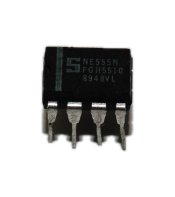- Home
- Learn Linux
- Learn Electronics
- Raspberry Pi
- Programming
- Projects
- LPI certification
- News & Reviews


12 December 2010
 In the fast changing world of hobby electronics there are not many books that have been around for over 30 years that have been reprinted almost every year with only some relatively small changes during the first few years. In fact this is probably the only book that is. Whilst that is a testament to how useful the 555 Timer IC (Integrated Circuit / Chip) is, how useful is a book that is over 30 years old?
In the fast changing world of hobby electronics there are not many books that have been around for over 30 years that have been reprinted almost every year with only some relatively small changes during the first few years. In fact this is probably the only book that is. Whilst that is a testament to how useful the 555 Timer IC (Integrated Circuit / Chip) is, how useful is a book that is over 30 years old?
The 555 timer IC is an 8 pin chip that can be used as either a timer or a multivibrator. As a timer this can be useful to introduce a delay or to extend the duration that something remains on (eg. light remains on for a minute after a button is pressed). In multivibrator mode many applications where a simple pulsing signal is required such as flashing lights or basic tone generation.
The 555 timer is still useful today in many of the same ways from when it was first available in 1971. It is a great first IC for those new to electronics and can still be useful for the more advanced electronic projects where a cheap simple timer is required.
The book provides a description of how the timer works internally as well as how to configure it in the various modes. The maths is kept to the minimum to show you how to select appropriate resistor and capacitor values for the appropriate timing, but if you don't want to follow the maths there is also a table showing some common combinations for certain timing intervals / frequencies.
The rest of the book then provides practical example circuits that can be created using the 555 timer as the main component. These include model railway circuits, automotive circuits and some sound generators as well as a few others.
Most of these are still useful today with the exception of the automotive circuits. Whilst the theory of how the circuits work is still valid these are either unnecessary these days (very few people have cars without lights-on reminders already installed) to some that are completely inappropriate for use on modern cars.
An example of a circuit that is completely inappropriate is the car theft deterrent which introduces a false signal to reduce performance and cause the car to misfire. I would strongly recommend against any such circuit on a car that has electronic engine management circuitry (ie. all modern cars). At the least this is likely to invalidate the car warranty, but could well cause permanent damage to the engine management system.
With the exception of the automotive examples the rest of the circuits are useful circuits for anyone starting out in electronics. The circuits are clearly described which will allow the hobby electronics enthusiast to understand how the circuit works and adapt as necessary for other requirements.
A worthwhile book for someone fairly new to electronics. You need to understand some basics of electronics first, but this book provides just about all you need to know to start making circuits with the 555 timer IC.